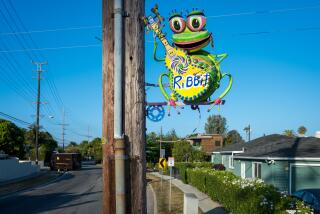Art or an Eyesore? : When one couple’s treasure is another’s trash, it’s up to city officials or homeowners’ associations to determine what is in good taste. Those involved in disputes find it difficult to love thy neighbor.
Your right to wear a mint-green polyester leisure suit ends where it meets my eye.
--Fran Lebowitz
In 1985, Bob Miller decided that it would be fun to paint his Costa Mesa house lime green and orange, accented with a tick-tack-toe pattern and other unconventional designs. It made a good, light-hearted story, a fine little bonbon to break the usual rhythm of war, politics and global strife. Undoubtedly, it made a lot of readers smile.
But not Miller’s neighbors. To them, the garish paint job was like a slap, a screaming bolt of citrus and doodles in the middle of rows of conventional color. It may have been Miller’s house, but they had to look at it. They complained angrily. Miller eventually painted the house gray.
Thursday in Laguna Beach, the city’s Design Review Board, six people appointed by the City Council to decide whether building projects are legal and appropriate to their surroundings, took a more tolerant view of home art and told Marie Forde that she and her husband Arnold can fill their pine tree with old water heaters and house trailers--as long as they do their best to keep the neighbors from seeing it.
It was the latest salvo in the is-it-art? vs. there-goes-the-neighborhood battle that has raged since man first burrowed into a hillside and started drawing on the walls. And the question, as always, was: where does your right of free visual expression end and my right not to look at it begin?
In the Orange County suburban sprawl, where tract homes often are the norm, a handful of such flamboyant squabbles have surfaced in recent years. Among them:
* In Costa Mesa, Sam Gregory has had a running cat-and-mouse game going with the city over his plans to build a castle-like house, complete with a rooftop swimming pool, an unusual carport and a moat. So far, the city has found no sections in the municipal codes that prevent Gregory from completing his project, but the local homeowners’ association has not been happy, contending that the castle is an eyesore.
* In Newport Beach, an eight-year legal battle was finally settled out of court over the question of whether a homeowner could install a basketball hoop over his garage door.
* In Irvine, the slow pace of construction on the home of Victor Ganish irked the neighbors. Ganish had been remodeling his home for four years, turning it into a kind of baroque castle. In response to complaints from neighbors, the city passed its Residence Remodeling Law, which requires that all remodeling work on a house be completed within a year of the issuance of a work permit.
The Laguna Beach installment of the continuing drama began when the Fordes announced their plans to commission Los Angeles-area artist Nancy Rubins to construct a sculpture in a large pine tree in the back yard of their Cliff Drive home. The sculpture, they said, would consist of 30 old water heaters and two house trailers, all entwined in the branches of the tree.
The top of the tree is barely visible from the street, and the back yard is perched atop a cliff overlooking the ocean.
A handful of the Fordes’ neighbors contended that the sculpture would not be art, but an eyesore. Not only that, they said, it would partially block their view of the ocean. They appealed to the Design Review Board to deny permission for the sculpture.
“I don’t think it’s art,” said Evelyn Gayman, one of the Fordes’ neighbors. “It’s an absurdity. I don’t think they have a right to put in something that’s not in keeping with the surroundings. This is a beautiful area, with beautiful shrubs and trees and the natural cliffs. I don’t think they’ll improve on nature by putting in something like they want to put in.”
Board member Barbara Metzger, in an interview earlier in the week, said she believed that this was something new. She could recall passing judgment on proposals for walls, pools, setbacks, additions, remodeling jobs and unusual forms of construction, but “I don’t think we’ve had an art object come before us before.”
“I think we encourage distinctive treatment of homes and we’re sensitive to uniqueness wherever we see it, so in that sense this is not a conventional community. But from my point of view, in this particular place where there’s the additional fact that this is defined as an environmentally sensitive zone--the oceanfront--and the structure is visible from the street and the beach, it seems to me that it conflicts with the natural setting. I think it’s a legitimate concern.”
Board member Jeffrey Powers, however, said he believed that “the sculpture is going in a very private place in the garden” and would not affect what the board called an “environmentally sensitive” area.
J.J. Gasparotti, another board member, said he believed the water heaters and house trailers were “materials integral to the artistic statement being made” and said the project should be viewed like any other addition to the property requiring board approval.
“It’s necessary to view this as a gray box,” he said.
Large names in the art world were brought into the fray, in the form of letters of support for Rubins’ work in general, and the Forde sculpture in particular, from Ned Rifkin, the chief curator for exhibits at the Hirshhorn Museum and Sculpture Gardens of the Smithsonian Institution; Ellen Breitman, the director of education and acting head of the curatorial department of the Newport Harbor art Museum; and Charles Desmaris, the director of the Laguna Art Museum.
When the bell sounded to end the final round, the Fordes were left with this: come back to the board with a plan to modify their landscaping--letting hedges grow higher, for instance--in such a way that the sculpture would be sufficiently blocked from most neighbors’ view.
The short version: work it out among yourselves.
Such questions involving modifying an existing house or landscape are rarely so nebulous, said Norma Herbel, the chief of land-use services for the county Environmental Management Agency’s regulation enforcement office. Many of the complaints her office receives, she said, have to do with violations of a county “nuisance ordinance,” a law that covers such blemishes as broken or discarded furniture or household equipment that is stored outdoors and is visible from a public street.
In such cases, she said, a neighbor usually calls her office to complain, and that person is asked to put the complaint in writing. If the complaint is found to be legitimate and in violation of a county law, the homeowner is asked to make the necessary changes. Some of the cases end up in court if the dispute becomes truly contentious.
But, said Herbel, if no one complains, the problem theoretically--or officially--doesn’t exist. It takes a complaint from a neighbor to start the governmental wheels turning.
“We do not drive around looking for complaints,” she said. “But if someone had written a letter and said someone was hanging (water heaters and trailers) from a tree, I would handle it like any other complaint. I’d stress to the homeowner that it’s kind of nice to live in harmony with their neighbors.”
But, she said, ruling on the case of the Fordes’ sculpture would require more than a conventional decision. Free artistic expression is involved, not simply the height of a wall, for instance.
“That,” she said, “is going to be a real tough one.”
It probably would not be nearly as difficult a call if the Fordes lived in Irvine, rather than Laguna Beach. Like every city, Irvine has zoning restrictions and laws that apply to residential development. Irvine, however, has a second filter of restrictions, enforced by individual homeowners’ associations.
It is these covenants, codes and restrictions (commonly called CC&Rs;), placed on individual developments by the original subdivider of the land, that deliver into the hands of the homeowners’ associations the power, among other things, to keep the neighborhoods homogenous in design.
The zoning laws, said Irvine principal planner Steve Haubert, are more general and refer to such things as pools, additional rooms, second-story units, satellite dishes and height and setback restrictions. It is the individual homeowners’ associations, he said, that decide such issues as color schemes, landscaping and how long garage doors may be left open unattended.
The power of the associations varies throughout the city, said Haubert, and has evolved over time. Some have become more restrictive than others. “It’s a quasi form of city government.”
And again, he said, if a dispute cannot be resolved at the homeowners’ association level, it goes to the courts.
Haubert said he didn’t know how a sculpture like the one proposed for the Fordes’ back yard would be received in Irvine.
“I can’t remember anything coming up like that in Irvine,” he said. “It would involve a whole gamut of issues.”
In Newport Beach, a dispute such as the one over the Forde sculpture might be ignored by the city if no broad codes were violated, said Jim Sinasek, supervisor of code enforcement for Newport Beach. Again, it would be a tough call. The construction of a flagpole, for instance, or a ham radio antenna, would require a permit. But in Newport Beach, the issue of aesthetics--generally--is not addressed by the city.
Homeowners’ associations enforce covenants, codes and restrictions in certain neighborhoods, said Sinasek, but where there are no such associations any disputes that aren’t covered in the city building codes must be handled by the homeowners themselves, face to face--or, possibly, attorney to attorney.
For instance, as far as the city is concerned, a Newport Beach resident whose neighborhood was not overseen by a homeowners’ association could paint his house lime green and orange with tick-tack-toe symbols with impunity.
In fact, said Sinasek, “we had an incident where a homeowner in town painted his structure a different color than what the neighbors were used to. We received letters complaining and we essentially took no action on it. There are no municipal codes governing what colors people can paint their houses.”
Sinasek wouldn’t say who the homeowner was, or what color he painted the house, only that it happened about 10 years ago and “it was very noticeable.”
And, he said, the paint job remains to this day.
More to Read
The biggest entertainment stories
Get our big stories about Hollywood, film, television, music, arts, culture and more right in your inbox as soon as they publish.
You may occasionally receive promotional content from the Los Angeles Times.










